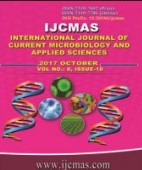


 National Academy of Agricultural Sciences (NAAS)
National Academy of Agricultural Sciences (NAAS)

|
PRINT ISSN : 2319-7692
Online ISSN : 2319-7706 Issues : 12 per year Publisher : Excellent Publishers Email : editorijcmas@gmail.com / submit@ijcmas.com Editor-in-chief: Dr.M.Prakash Index Copernicus ICV 2018: 95.39 NAAS RATING 2020: 5.38 |
The present studies were carried out to know the diversity in morphology of stingless bee Tetragonulairidipennis in Coimbatore, Erode and Tiruppur districts of Tamil Nadu, India. Adult worker bees were collected from identified feral nest of T. iridipennis in three different locations and bees were preserved in 70% ethanol. The preserved bees were dissected and fourteen morphometric measurements were studied using Leica M 165C stereo microscope. Morphometric analysis revealed that the bees collected from Coimbatore district were comparatively larger (Mean of HL= 1.53, HW 1.76, AL 1.87, HLL 3.46 and BTL 0.57 FL 4.00, WL2= 1.19, HTL=1.60 mm) compared to other two districts. The bees collected from Erode district are relatively small (Mean of HL= 1.23, HW= 1.62, AL 1.67, HLL 3.26 and BTL 0.44, FL 3.32, WL2= 0.89, HTL=1.31 mm). However there is no difference observed in number of hamuli (5) irrespective of the district from which bees are collected. The results of PCA showed that the cumulative variance of the three principal components reached 54% (PC 1), 29.3% (PC 2) and 6.2% (PC 3). The most discriminative characters recorded in the principle component analysis are FL, HTL, BTL, HW, FW, AL and WL2. These characters supported in forming three distinct clusters.
 |
 |
 |
 |
 |